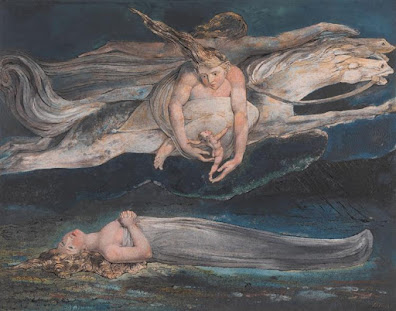Billy Blake may very well be the top of the list for paradoxical poets of the Romantic Era. Even the modern era has trouble bubbling up a versifier as open and ablaze as our Billy.
If one knows any of Blake’s poems (or at least the first line), it’s almost certainly “The Tyger.” This poem is typically following by “The Lamb,” his juxtaposition of two near opposites, who in the poet’s skilled hands, emerge as an unlikely unity of opposites.
“The Tyger” and “The Lamb” suggest Blake's idea that God created binary oppositions – including light and darkness, which reveal two complementary aspects of God’s character. Read together, these two poems were controversial pieces of writing in the eighteenth century. Implying that God could be dark was not well received, and like so many works of Romantic literature, these poems not reach their current popularity until long after Blake’s death. As is so often the case for Romantic authors, these poems are criticized by society, and society is criticized by these poems.
NOTE: A sample of Blake’s paintings appears at the end of this post.
Tyger Tyger, burning bright,
In the forests of the night;
What immortal hand or eye,
Could frame thy fearful symmetry?
In what distant deeps or skies.
Burnt the fire of thine eyes?
On what wings dare he aspire?
What the hand, dare seize the fire?
And what shoulder, & what art,
Could twist the sinews of thy heart?
And when thy heart began to beat,
What dread hand? & what dread feet?
What the hammer? what the chain,
In what furnace was thy brain?
What the anvil? what dread grasp,
Dare its deadly terrors clasp!
When the stars threw down their spears
And water’d heaven with their tears:
Did he smile his work to see?
Did he who made the Lamb make thee?
Tyger Tyger burning bright,
In the forests of the night:
What immortal hand or eye,
Dare frame thy fearful symmetry?
Little Lamb who made thee
Dost thou know who made thee
Gave thee life & bid thee feed.
By the stream & o’er the mead;
Gave thee clothing of delight,
Softest clothing wooly bright;
Gave thee such a tender voice,
Making all the vales rejoice!
Little Lamb who made thee
Dost thou know who made thee
Little Lamb I’ll tell thee,
Little Lamb I’ll tell thee!
He is called by thy name,
For he calls himself a Lamb:
He is meek & he is mild,
He became a little child:
I a child & thou a lamb,
We are called by his name.
Little Lamb God bless thee.
Little Lamb God bless thee.
Background
Poet, painter, engraver, and visionary, William Blake worked to bring about a change both in the social order and in the minds of men. Though in his lifetime his work was largely neglected or dismissed, he is now considered one of the leading lights of English poetry, and his work has only grown in popularity. In his Life of William Blake (1863) Alexander Gilchrist warned his readers that Blake “neither wrote nor drew for the many, hardly for work’y-day men at all, rather for children and angels; himself ‘a divine child,’ whose playthings were sun, moon, and stars, the heavens and the earth.” Yet Blake himself believed that his writings were of national importance and that they could be understood by a majority of his peers. Far from being an isolated mystic, Blake lived and worked in the teeming metropolis of London at a time of great social and political change that profoundly influenced his writing. In addition to being considered one of the most visionary of English poets and one of the great progenitors of English Romanticism, his visual artwork is highly regarded around the world.
Exploration 1: Explain, if you wish, what Blake might mean by “fearful symmetry,” in the first stanza of “Tyger.”
Exploration 2: Why does Blake address the Lamb with the question, “Dost thou know who made thee?”
Exploration 3: What is it about the two poems that invites a simultaneous pairing? In other words, what meanings or themes in the poems make their own “symmetry” and yet distinctive differences?
Exploration 4: Can something be both beautiful and destructive? Likewise, can something be innocent and destroyed?
Deeply religious, Blake's works were based on visions of angels, spirits, and demons he had since childhood.







1. Tooth and claw. A tiger will eat you if you meet one in the jungle.
ReplyDelete2. He wants the reader to give the answer.
3. That’s a mighty question.
4. We all contain the seeds of good and evil. Can something be innocent and destroyed? Did you mean innocent and destructive? Yes to either question.
5. Nice portrait of WW. A perfect lamb.
W.W. ? Hardly a perfect lamb, but perhaps a wolf in sheep's clothing instead, for if one concentrates on the center of this portrait one can conceive a rather evil-looking baggy-eyed image of none other than a Looney Tunes's wide-nosed Yosemite Sam.
ReplyDelete"Say your prayers, varmint!”"
"I'm the hootin'est, tootin'est, shootin'est, bob-tail wildcat, in the west!”
“I’m no doc, ya flea-bitten varmint. I’m Riff-Raff Sam, the riffiest riff that ever riffed a raff!”
“Let me tell you rabbit that I am using force because you have forced me to use it.”
And another hundred quotes attributed to Yosemite Sam over the years.
And, "Uffdah, dat's vun mean 'ombre!"
I had a Yosemite Sam t-shirt when I was younger. His picture showed him with a gun in each hand, shooting out at about 45 degrees - a line from the mid-chest. The barrels pointed strategically and naughtily from mid-chest, Can you picture it? Alas, the center of the chest has become baggy like the "evil-looking- eyed image." Alas! Woe is me! No Woe is him.
Delete